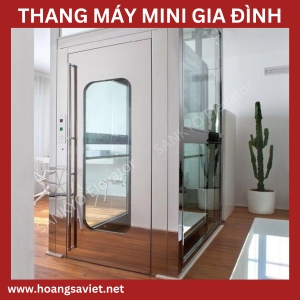The system is processing. Please wait a moment!
- Home experience homelift & elevator technical Sharing experiences
Compare 3 Elevator Types: Cable, Hydraulic, Screw
TABLE OF CONTENTS
Elevator technology has made great strides, playing an important role in improving the efficiency of transporting goods and people, especially in modern constructions. Among the popular elevator lines today, hydraulic elevators, cable elevators and screw elevators are three prominent options, each with its own advantages and characteristics, providing flexibility and diversity in practical applications.
The article "Comparison of 3 elevator lines: traction, hydraulic, screw" by SANKYO Hoang Sa Viet Elevator will help you have a more general view of the rich diversity of elevator types in the transportation industry. We will learn about each elevator line in detail, analyze the differences, advantages and disadvantages to clearly see how they contribute to improving the quality of life and supporting activities in modern urbanized environments. Let's start the journey of discovery to find out why these elevator lines have become the top choice for projects from civil to commercial and industrial!
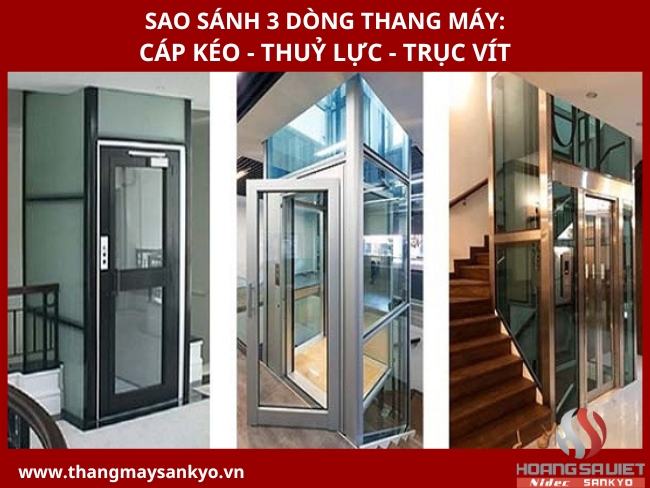
CABLE ELEVATOR?
Family elevators using traction cable technology are a modern solution, providing simple but highly effective operation. The system operates based on a pulley mechanism that is closely linked to the electric motor. When the user selects the desired floor through the control panel, the system will immediately activate the electric current, causing the motor to start rotating. The movement of the motor simultaneously controls the pulleys to rotate, creating traction for the cabin to move up or down according to the set requirements.
SEE MORE ARTICLES
The special feature of this technology is the ability to flexibly adjust the rotation direction of the pulley and motor, suitable for the selected direction of movement. The operation process takes place smoothly and accurately, ensuring that the cabin stops at the desired floor position. Thanks to its smart design and high performance, the cable elevator not only meets the needs of daily use but also brings safety and convenience to families, especially in projects with limited installation space.
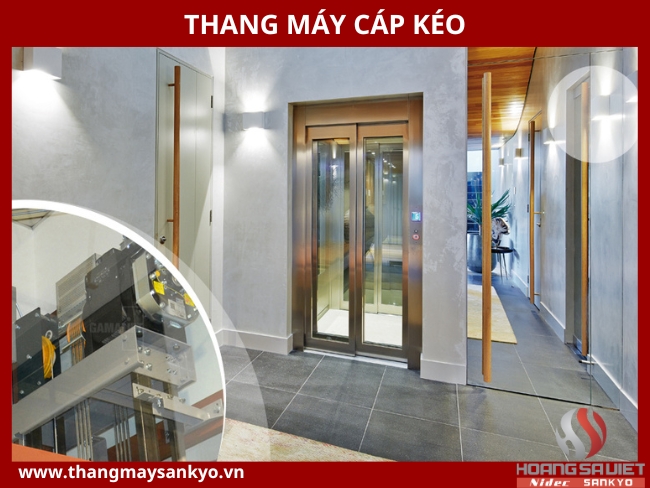
Structure of cable elevator
Elevator motor (or traction machine):
Elevator motors, also known as traction machines, play an important role in providing the necessary energy to operate the elevator system , ensuring that the cabin can move up and down stably and safely. This is the core part of the cable traction elevator, operating based on the pulley rotation mechanism to create traction or lower the cabin as required. Currently, elevator motors are divided into two main types, including geared electric motors and new generation gearless motors.
Geared motors are commonly used in traditional elevators , featuring durable operation and suitable for large-load constructions. Meanwhile, gearless motors using modern permanent magnet technology offer many outstanding advantages. This type of motor not only helps reduce the size and weight of the device, but also optimizes operating performance, thereby helping the elevator move more smoothly, quietly and save energy.
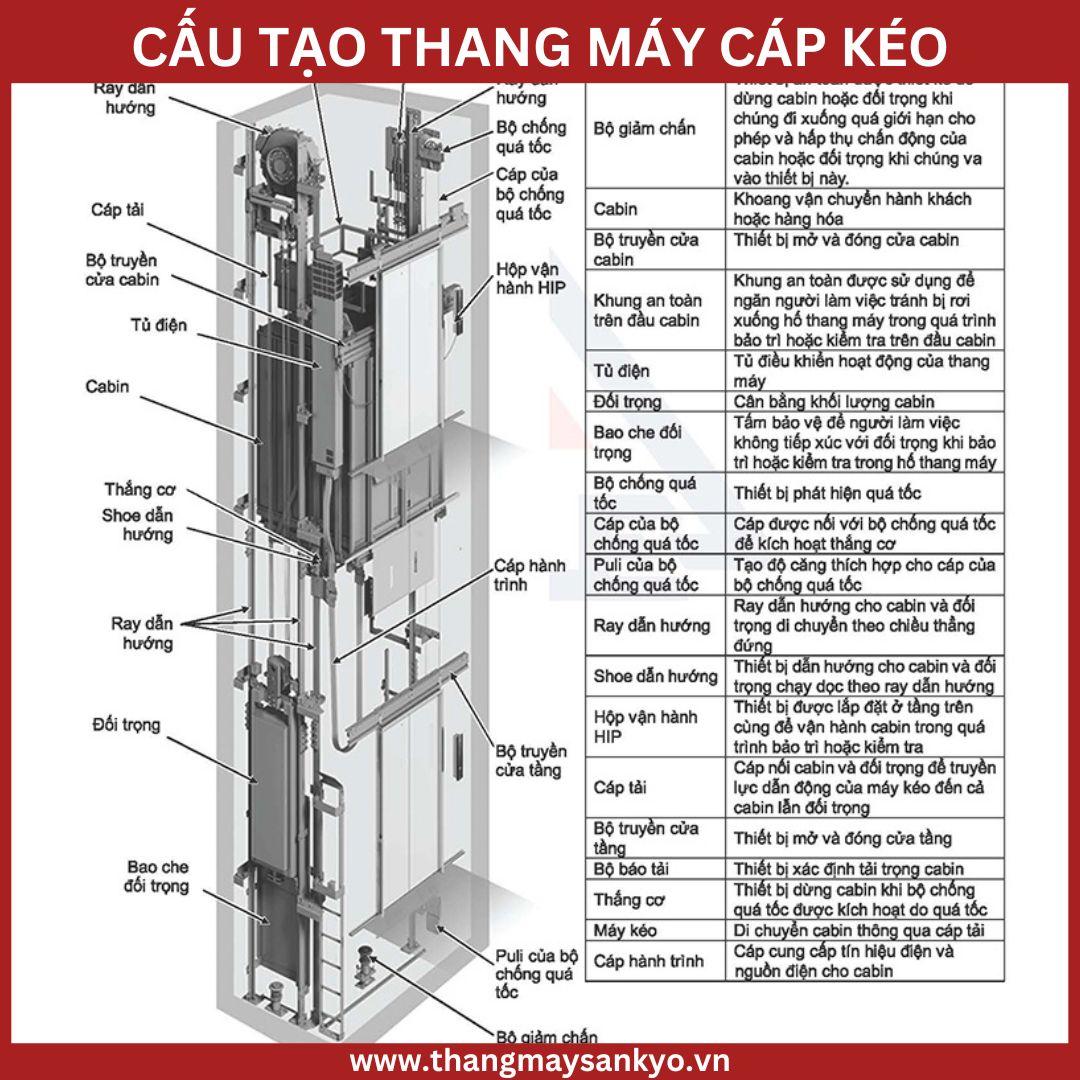
In addition, the permanent magnet technology in the gearless motor also helps to reduce noise and limit vibration, providing a more comfortable user experience. With the ability to adjust movement precisely and effectively, the new generation elevator motor is becoming an increasingly popular choice, especially in home elevator projects or high-end buildings where performance and aesthetics are highly required.
Cable system
The cable system plays a central role in the operating mechanism of the traction elevator , ensuring the safe and efficient movement of the cabin. The elevator uses one or more high-quality cables, specially designed to withstand heavy loads and have high durability. These cables are connected to the cabin at one end and the other end is connected to the counterweight via the traction machine pulley. This mechanism helps to create a balance between the cabin and the counterweight, while minimizing the energy required to operate the system.
During operation, as the cabin moves up, the counterweight moves down in the opposite direction and vice versa, helping to maintain stability and optimize traction. The cable system is designed to work in coordination with the pulley and motor, ensuring that the cabin can move smoothly and accurately to the required floor.
In addition, the use of specialized cables also helps increase the safety and longevity of the elevator , minimizing wear or damage during operation. The cable system is periodically maintained to ensure absolute safety, while meeting the needs of use in modern works. With this important role, the cable system is an indispensable factor, contributing to the efficiency and reliability of the cable elevator.
SEE MORE PRODUCTS:
Elevator cabin:
The elevator cabin is an important part, which directly serves the user's travel needs in the cable elevator system. The cabin is usually made from high-strength materials, ensuring durability and maximum safety during use. The cabin frame is usually made of sturdy steel, combined with shiny, rust-proof stainless steel walls or modern tempered glass walls, creating a feeling of spaciousness and luxury. These materials not only help the cabin withstand heavy loads but also bring aesthetic beauty, suitable for many different architectural spaces.
Cabin sizes are highly flexible, custom-designed based on specific uses. For passenger elevators, the cabin is often compact in size but still ensures a comfortable, convenient space. Meanwhile, freight elevator models often have larger cabins, with a reinforced load-bearing structure, helping to safely transport heavy objects.
In addition, the interior of the cabin is also focused on, often equipped with a modern lighting system, a cabin floor made of anti-slip materials and easy-to-use, user-friendly control buttons. The cabin is not only a place to perform the function of movement but also shows aesthetics and comfort, contributing to improving the user experience in civil and commercial works.
SEE MORE ARTICLES
Electrical cabinets and control panels:
Electrical cabinets and control panels play an important role in the operation and management of cable-driven elevators, ensuring that the system operates safely, efficiently and meets the needs of users. Passenger control panels are located in various locations, including inside the cabin, outside on floors and in the elevator waiting area . These control panels are designed to be user-friendly and easy to operate with clear buttons, displaying the current floor, floor selection buttons, as well as function buttons such as door opening, door closing and emergency alarm.
When passengers press the floor selection button or perform any command from the control panel, the control signal will be immediately transmitted to the central controller, the "brain" of the entire system, located in the electrical cabinet. Here, the central controller will process the signals, calculate and give precise operating commands for the elevator to move to the requested floor, while adjusting the speed, stopping position and opening the cabin door.
Tủ điện không chỉ chứa bộ điều khiển trung tâm mà còn tích hợp các linh kiện và thiết bị quan trọng khác như bộ chuyển đổi, nguồn cung cấp điện, hệ thống an toàn, và các thiết bị chống quá tải. Nhờ vào sự phối hợp nhịp nhàng giữa tủ điện và bảng điều khiển, thang máy vận hành một cách mượt mà, đảm bảo sự tiện nghi và an toàn tối đa cho hành khách. Việc thiết kế và lắp đặt tủ điện và bảng điều khiển luôn được chú trọng để phù hợp với đặc điểm từng công trình, từ nhà ở dân dụng đến các tòa nhà thương mại hoặc công nghiệp.
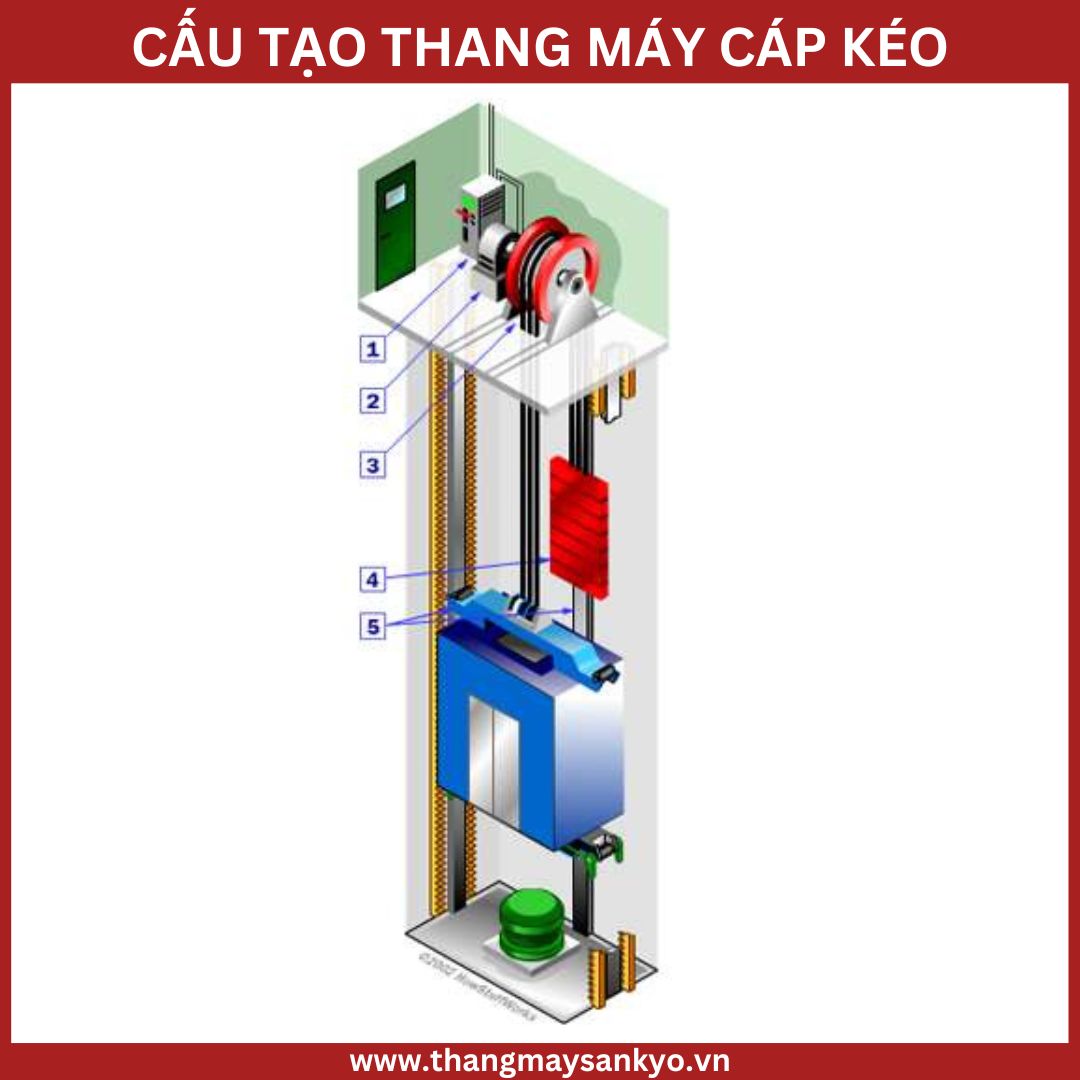
Hệ thống đảm bảo an toàn:
Hệ thống đảm bảo an toàn là một trong những yếu tố quan trọng hàng đầu trong thiết kế và vận hành thang máy cáp kéo, giúp bảo vệ hành khách và ngăn ngừa các sự cố tiềm ẩn. Để đáp ứng tiêu chuẩn an toàn cao, thang máy cáp kéo được trang bị nhiều tính năng và công nghệ hiện đại. Một trong số đó là cảm biến va chạm, có khả năng phát hiện các vật cản trong quá trình đóng mở cửa hoặc di chuyển cabin, từ đó kích hoạt cơ chế dừng khẩn cấp để tránh tai nạn.
Bên cạnh đó, hệ thống phanh khẩn cấp đóng vai trò như một lớp bảo vệ quan trọng trong trường hợp xảy ra mất điện đột ngột hoặc lỗi hệ thống. Hệ thống này tự động kích hoạt, giữ cố định cabin và ngăn không cho cabin di chuyển ngoài ý muốn, đảm bảo hành khách bên trong luôn an toàn.
Ngoài ra, bảng điều khiển an toàn được tích hợp trong hệ thống vận hành giúp xử lý nhanh chóng các tình huống khẩn cấp. Chẳng hạn, khi cabin gặp sự cố, hành khách có thể sử dụng nút báo động để kết nối với đội kỹ thuật, trong khi bộ điều khiển trung tâm sẽ kích hoạt các quy trình ứng phó cần thiết. Nhờ vào các tính năng an toàn tiên tiến này, thang máy cáp kéo không chỉ mang lại sự tiện lợi mà còn đảm bảo độ tin cậy cao trong mọi tình huống sử dụng.
XEM THÊM SẢN PHẨM KHÁC:
Dự phòng điện năng:
Hệ thống dự phòng điện năng đóng vai trò quan trọng trong việc đảm bảo hoạt động liên tục và an toàn của thang máy cáp kéo, đặc biệt trong trường hợp mất điện đột ngột. Để tránh tình trạng người sử dụng bị kẹt trong cabin hoặc thang máy ngừng hoạt động khi nguồn điện chính bị gián đoạn, một hệ thống acquy dự phòng được tích hợp vào thiết kế.
Hệ thống này cung cấp một nguồn điện tạm thời, đủ để thang máy hoàn thành hành trình đang di chuyển, đưa cabin đến tầng gần nhất và mở cửa để hành khách có thể thoát ra an toàn. Ngoài ra, hệ thống dự phòng còn đảm bảo các thiết bị quan trọng như đèn chiếu sáng, hệ thống thông gió trong cabin và các chức năng điều khiển cơ bản tiếp tục hoạt động trong thời gian ngắn, giúp giảm thiểu tối đa sự bất tiện và nguy cơ tiềm ẩn.
Việc sử dụng hệ thống acquy dự phòng không chỉ nâng cao trải nghiệm của người dùng mà còn khẳng định tiêu chuẩn an toàn cao trong thiết kế thang máy hiện đại, đảm bảo sự an tâm và tin cậy trong mọi điều kiện vận hành.
Nguyên lý hoạt động của thang máy cáp kéo
Thang máy cáp kéo hoạt động dựa trên nguyên lý kết hợp giữa động cơ điện, hệ thống puly, cáp thép và đối trọng. Động cơ điện cung cấp năng lượng quay cho puly, giúp kéo cáp thép di chuyển cabin lên hoặc xuống. Cáp thép được quấn quanh puly và kết nối với cabin thang máy cùng đối trọng, đảm nhận vai trò cân bằng trọng lực. Khi động cơ quay, cáp sẽ kéo cabin di chuyển theo chiều mong muốn, trong khi đối trọng di chuyển ngược lại để cân bằng và giảm tải cho động cơ. Hệ thống cảm biến và bộ điều khiển giúp đảm bảo thang máy dừng đúng vị trí, trong khi phanh tự động giữ cabin ổn định khi không hoạt động. Nhờ vào nguyên lý này, thang máy cáp kéo mang lại hiệu suất cao, tiết kiệm năng lượng và đảm bảo an toàn cho người sử dụng.
XEM THÊM BÀI VIẾT KHÁC
Các loại thang máy cáp kéo hiện nay
Thang máy cáp kéo dùng động cơ có hộp số
Thang máy cáp kéo sử dụng động cơ có hộp số là một dòng thang máy truyền thống được thiết kế với hệ thống phòng máy riêng biệt. Dòng thang máy này hoạt động với tốc độ tối đa lên đến 500 feet/phút và có thể chịu tải trọng lên tới 13.000 kg, phù hợp với các công trình có nhu cầu di chuyển khối lượng lớn hoặc các tòa nhà cao tầng. Mặc dù tốc độ di chuyển của thang máy có hộp số thấp hơn so với các loại thang máy không hộp số, nhưng ưu điểm lớn của chúng là chi phí đầu tư thấp hơn và động cơ điện có công suất không quá lớn, giúp tiết kiệm chi phí vận hành.
Thang máy cáp kéo có phòng máy sử dụng động cơ không đồng bộ kết hợp với cơ chế giảm tốc giúp vận hành êm ái và dễ bảo trì. Tuy nhiên, loại thang máy này cũng gặp phải một số hạn chế nhất định, bao gồm hiệu suất động cơ không cao bằng các loại thang máy khác, khối lượng của thiết bị lớn, hiệu suất truyền động thấp và tiêu thụ năng lượng cao. Bên cạnh đó, thang máy có phòng máy cũng tạo ra mức độ tiếng ồn cao hơn so với các dòng thang máy hiện đại khác, và đôi khi sự thoải mái trong quá trình di chuyển có thể không được tốt như các công nghệ thang máy mới. Tuy nhiên, với chi phí đầu tư hợp lý và khả năng đáp ứng nhu cầu vận hành bền bỉ, thang máy cáp kéo sử dụng động cơ có hộp số vẫn là sự lựa chọn phổ biến trong nhiều công trình, đặc biệt là các công trình lớn, nơi yêu cầu tải trọng cao và tần suất sử dụng ổn định.
Thang máy cáp kéo dùng động cơ không hộp số
Thang máy cáp kéo sử dụng động cơ không hộp số hiện nay đang ngày càng phổ biến và chiếm khoảng 70-80% thị phần, đặc biệt trong các công trình xây dựng trung và cao tầng. Loại thang máy này đã trở thành sự lựa chọn chủ đạo trong các công trình yêu cầu khả năng vận hành nhanh chóng và hiệu quả, như thang máy tải khách và tải hàng. Với khả năng vận hành ở tốc độ cao, thang máy động cơ không hộp số mang đến sự thuận tiện và tiết kiệm cho các tòa nhà có yêu cầu di chuyển nhanh chóng giữa các tầng. Khác với thang máy sử dụng động cơ có hộp số, thang máy không hộp số có động cơ điện được kết nối trực tiếp với puly, giúp giảm thiểu sự phức tạp của hệ thống và nâng cao hiệu quả hoạt động.
Mô hình thang máy không hộp số thường được trang bị động cơ đồng bộ với cấu trúc đơn giản, nhẹ nhàng và hiệu suất cao. Loại động cơ này có khả năng hoạt động ổn định, với mô-men xoắn cao và tốc độ thấp, mang lại sự chính xác và độ bền trong suốt quá trình sử dụng. Tùy thuộc vào thiết kế và ứng dụng, thang máy không hộp số có thể vận hành với tốc độ từ 1m/s đến 20m/s, phục vụ đa dạng nhu cầu di chuyển trong các công trình khác nhau. Đặc biệt, đối với các công trình nhà ở gia đình, thang máy này có thể được điều chỉnh để vận hành ở tốc độ thấp từ 0.6m/s đến 1m/s, rất phù hợp với các căn hộ hoặc nhà ở có từ 4-6 tầng.
Mặc dù thang máy không hộp số có mức đầu tư ban đầu cao hơn, nhưng chi phí bảo trì của chúng tương đối thấp và tiết kiệm năng lượng so với các loại động cơ có hộp số truyền thống. Nhờ vào sự tiết kiệm năng lượng và hiệu quả vận hành, thang máy động cơ không hộp số trở thành lựa chọn lý tưởng cho các công trình cao tầng, siêu cao tầng, nơi yêu cầu tốc độ di chuyển nhanh và chi phí vận hành hợp lý.
XEM THÊM SẢN PHẨM KHÁC:
Thang máy cáp kéo không phòng máy (MRL)
Sự ra đời của động cơ không hộp số với kích thước nhỏ gọn đã đánh dấu một bước tiến quan trọng trong việc cải tiến thiết kế thang máy, đặc biệt là trong các tòa nhà hiện đại. Trước đây, thang máy truyền thống thường yêu cầu một phòng máy riêng biệt để đặt động cơ, nhưng với thang máy sử dụng động cơ không hộp số, động cơ có thể được thiết kế và đặt ngay trên đỉnh giếng thang. Thiết kế này không chỉ giúp giảm kích thước và trọng lượng của hệ thống thang máy mà còn mang lại khả năng tiết kiệm không gian đáng kể cho tòa nhà. Đây là cơ sở cho sự ra đời của dòng thang máy không phòng máy (Machine Room Less - MRL), một giải pháp tối ưu cho những công trình yêu cầu tiết kiệm diện tích.
MRL elevators do not require a separate machine room, thus saving space in the building, while minimizing initial investment costs and installation time. The electric motors are mainly located inside the elevator shaft, optimizing system installation and maintenance. The system is also highly energy efficient and does not use oil or lubricants, thereby minimizing environmental pollution and eliminating potential fire hazards. Although MRL elevators have operating speeds comparable to traditional gearless elevator models , thanks to their simple design and energy efficiency, MRL elevators are becoming an increasingly popular choice for modern buildings, apartment buildings, or structures with limited space.
Advantages of cable elevators
Cable elevators have many outstanding advantages and are the ideal choice for many projects today. One of the biggest strengths of cable elevators is their affordable price, especially when there are many manufacturers participating in the market. Competition between manufacturers helps reduce prices, bringing significant benefits to consumers while still ensuring product quality. In addition, cable elevators also stand out with their ability to transport quickly and efficiently, helping to save time moving between floors of the building. In particular, cable elevator technology has undergone more than 200 years of development and improvement, providing stability and high durability. With a long history and proven over time, today's cable elevators are not only reliable but also bring peace of mind to users during operation. Thanks to these advantages, cable elevators are always a popular and preferred choice in many types of projects, from high-rise buildings to commercial buildings.
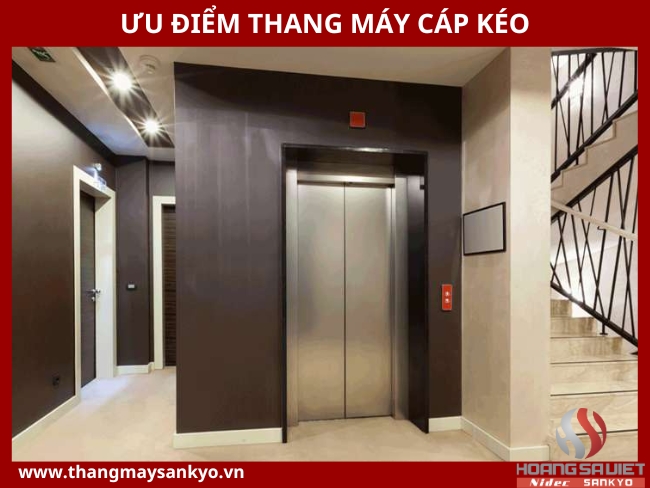
Disadvantages of cable elevators
One of the main disadvantages of cable elevators is that they take up more space in the house than some other types of elevators. This comes from the structure and size of the cable elevator, which requires a free space to install the cabin, counterweight, machine room, and pit.
The need for counterweight space reduces the usable area of the cabin. In particular, to install this elevator , a pit, that is, an underground space to accommodate the elevator's operating equipment, is required. This requires the construction of a pit, creating a separate empty space under the floor. This process requires careful calculation before the house is built, and can create unexpected problems and costs if not carefully planned.
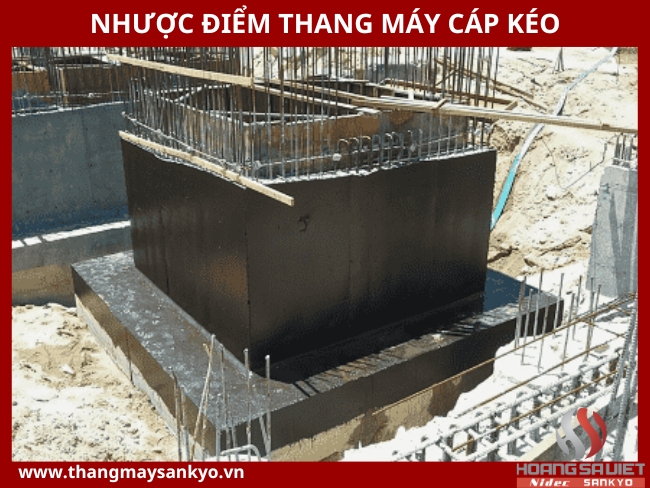
Which projects are cable elevators suitable for?
Cable traction elevators are a popular and versatile type of elevator, widely used in many types of constructions thanks to their efficient operation and space saving capabilities. Below are the constructions suitable for this type of elevator:
Residential and villas
Cable-driven elevators are widely chosen for residential buildings and villas thanks to their compact design and variety of styles. This type of elevator not only meets the need for convenient movement but also contributes to enhancing the aesthetic value of the living space. In particular, for high-end villas, luxurious glass or stainless steel cable-driven elevators are often preferred to create architectural highlights.
High-rise apartments and condominiums
High-rise apartments and condominiums often use cable-driven elevators due to their large load capacity, stable operation, and fast moving speed. For these buildings, the elevator system is not only a means of transportation but also a factor ensuring the comfort and safety of residents.
Office Buildings
In office buildings, cable-driven elevators are widely used to meet the mobility needs of employees and customers. These buildings often require elevators with high speed, continuous operation and superior durability to suit the high frequency of use.
SEE MORE PRODUCTS:
Hotels and resorts
For hotels and resorts, cable car elevators not only serve as transportation but also as a factor that impresses customers. This type of elevator is often designed in a modern or classic style to harmonize with the overall architecture, providing a comfortable and convenient experience for visitors.
Shopping malls and supermarkets
In shopping malls and supermarkets, heavy-duty cable-driven elevators are preferred for transporting goods and customers between floors. In particular, elevators with spacious cabins and airy designs help increase operating efficiency in crowded spaces.
Hospitals and medical facilities
In hospitals, cable elevators are used to transport patients, medical staff, and medical equipment. This type of elevator is often designed with a large cabin, smooth operation to meet specific medical requirements, ensuring safety and convenience.
Thanks to its flexible adaptability and design diversity, cable elevators are the ideal solution for many types of projects, from residential houses to large complex buildings, meeting all needs in terms of comfort, aesthetics and operational efficiency.
SEE MORE ARTICLES
WHAT IS A HYDRAULIC ELEVATOR?
Hydraulic elevators are a type of elevator that operates based on the principle of using the pressure of oil or hydraulic fluid to move the elevator cabin. The structure of this system includes a hydraulic pump, which is responsible for pushing oil into a hydraulic cylinder. When the oil is compressed into the cylinder, the pressure from the oil will create the force for the elevator cabin to move up or down. This process takes place thanks to the change in pressure in the oil system, helping the cabin to move flexibly and stably. When the oil is released from the cylinder, the elevator cabin will lower in the opposite direction.
Hydraulic elevators are ideal for low to medium height buildings, such as low-rise buildings, single-family homes, or buildings that do not have enough space to accommodate a traditional elevator machine room. What is special about hydraulic elevators is that they do not require traction cables like traditional elevators, but instead are installed under the cabin or on the side of the elevator shaft. Therefore, this type of elevator is very suitable for buildings with limited space and requires quick and easy installation while still ensuring efficiency during operation. In addition, hydraulic elevators also have the advantage of saving space, requiring little maintenance, and can operate smoothly and safely even in power outages.
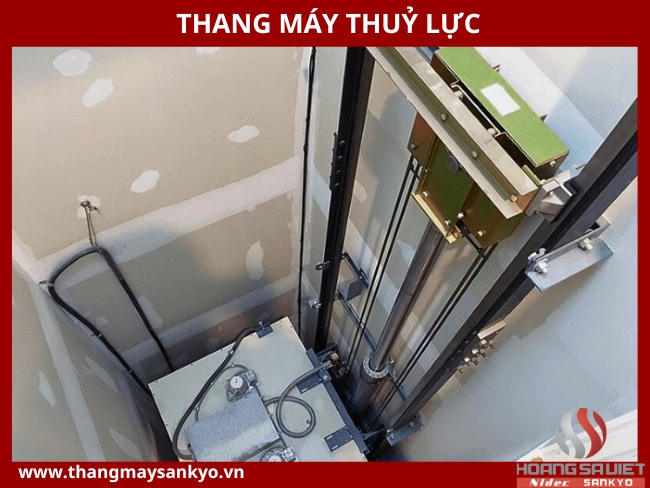
Structure of hydraulic elevator
Central control cabinet
The central control cabinet of the hydraulic elevator is installed outside the elevator shaft, usually on the lowest floor of the building, with a maximum distance of up to 7m from the elevator shaft. This is an important part of the hydraulic elevator system, which plays a role in ensuring that the elevator's operations take place accurately and safely. Inside the central control cabinet, there are many components that work together to ensure the smooth operation of the elevator.
One of the main parts is the engine, which operates the pump to create thrust on the hydraulic cylinder, thereby helping the elevator move up or down according to the user's request. Along with that, the hydraulic oil tank is used to store a special type of lubricating oil, which both functions to create pressure in the hydraulic cylinder and helps the elevator components operate smoothly and efficiently. The control system in the cabinet helps coordinate the elevator's operations, ensuring that the functions are performed accurately, from receiving user signals to performing cabin movements. Finally, the hydraulic valve system plays an important role in regulating the flow of fluid, ensuring that the hydraulic oil is directed to the necessary locations in the system, helping the elevator operate stably and efficiently. All of these parts work together to ensure that the hydraulic elevator operates safely and accurately throughout its use.
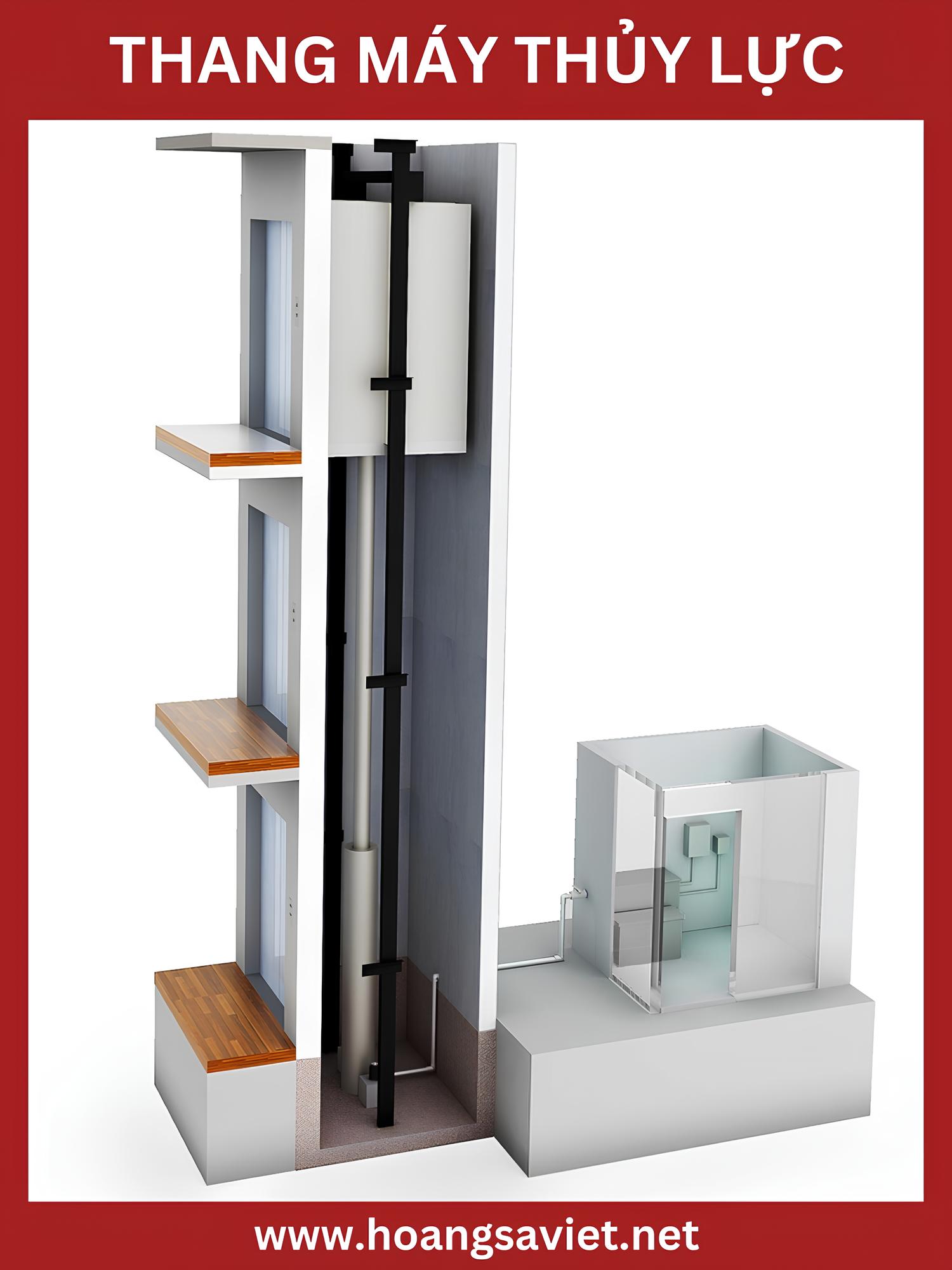
Mechanical system
The mechanical system of a hydraulic elevator plays an important role in ensuring stability and accuracy during operation. The main components of this system include the cabin frame, guide rails, guide shoes and many other details, all of which are designed to help the elevator move straight, without deviation, while maintaining balance and stability throughout the movement.
The cabin frame is the main structural part, responsible for supporting and protecting the elevator cabin, helping the cabin move safely and firmly. The guide rails and guide shoes play an important role in positioning and controlling the movement of the cabin, ensuring that the cabin moves along a certain trajectory without deviation or entanglement. Other details in the mechanical system also contribute to maintaining the stability and accuracy of the movement, while helping the elevator operate smoothly and durably. All these parts work closely together to ensure that the hydraulic elevator not only operates efficiently but is also safe for users.
Elevator shaft and cabin frame system
The elevator shaft and cabin frame system are important parts of the elevator structure, ensuring that the user's movement is carried out safely and conveniently. The cabin floor door, elevator cabin and elevator shaft frame are designed and installed tightly, scientifically linked together to form a synchronous system.
Cabin doors are installed on each floor of the building, making it easy for users to get in and out of the elevator. The elevator cabin is where passengers or goods are stored during the movement between floors, designed with a sturdy and convenient structure. The elevator shaft frame, which acts as the "backbone" of the elevator system, is the main structure that helps fix and support the cabin to move up and down vertically in the elevator shaft.
SEE MORE PRODUCTS:
When these parts work together, they create a smooth elevator operation process, ensuring absolute safety for users. In addition, the connection between these parts also helps limit technical problems, ensuring that the elevator will always operate efficiently and stably, while meeting the user's travel needs in all situations.
Hydraulic piston
The hydraulic piston is an important part of the hydraulic elevator system, playing a direct role in the cabin to create movement up or down. The hydraulic piston has a maximum length of up to 18m, with a diameter ranging from 100mm to 200mm, helping to ensure stable and efficient operation. The hydraulic fluid pipe has a diameter of about 5mm, which is the part that connects to the piston and the hydraulic oil tank, helping to lead oil into the piston to create the necessary thrust for the elevator movement .
When oil is pumped into the cylinder, the piston will move up or down, causing the elevator cabin to move accordingly. The characteristic of hydraulic pistons is the ability to create very strong force, helping the elevator to operate smoothly and stably even when lifting or lowering large loads. Designed with high technical standards, hydraulic pistons ensure durability and outstanding performance throughout the use, helping the elevator operate safely and effectively in all conditions.
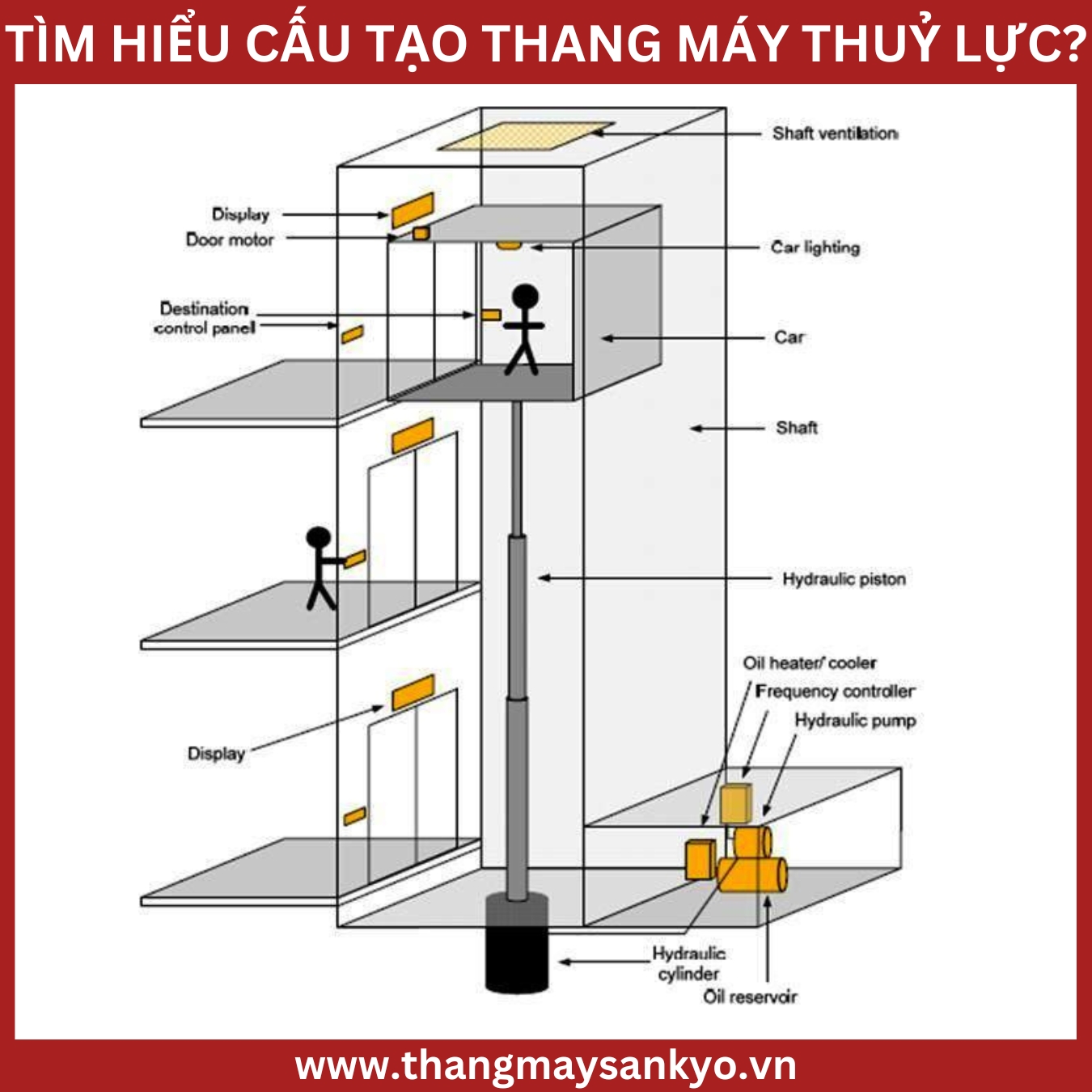
Working principle of hydraulic elevator
The working principle of a hydraulic elevator is based on the use of liquid pressure (usually hydraulic oil) to create thrust, helping the elevator cabin move up or down. The basic system of a hydraulic elevator consists of a hydraulic pump, a hydraulic cylinder, a piston and an oil tank. When the hydraulic pump operates, it pushes oil into the cylinder, creating pressure that causes the piston to move up, pulling the elevator cabin up. When the cabin needs to be lowered, the oil is discharged from the cylinder, reducing the pressure and allowing the piston to move back, helping the cabin move down. This system does not require a traction cable like a cable elevator, but instead uses hydraulic force to control the movement, providing a space-saving and easy-to-maintain solution, suitable for low-rise buildings or buildings without space for a machine room.
SEE MORE ARTICLES
Advantages of hydraulic elevators
Hydraulic elevators offer many outstanding advantages, especially in applications that require space saving and performance optimization. One of the highlights of hydraulic elevator technology is the modernity and advancement in design and operation. Advances in the use of new components and materials, along with optimized installation and control processes, help improve operating efficiency and improve elevator safety. These improvements help reduce incidents, maintenance time, and provide a smoother and safer travel experience for users. At the same time, hydraulic elevators also help increase reliability and convenience throughout the use process.
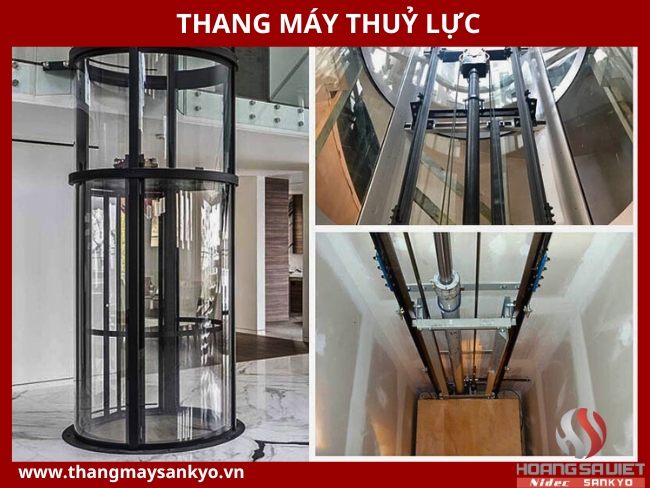
In addition, hydraulic elevators also help save significant space, up to 80-90% compared to traditional elevators. With a neat and minimalist design, hydraulic elevators do not need counterweights and have few complicated details, thereby creating a slim and harmonious shape with the surrounding space. This is especially useful in buildings with limited space or space-saving requirements. With an installation area of only about 1m², hydraulic elevators are easily integrated into living or working spaces without taking up too much space, bringing maximum convenience to users.
Disadvantages of hydraulic elevators
- Limited installation height (usually hydraulic elevators do not make >3 floors)
- In addition, the transportation speed of hydraulic elevators is often not as fast as other types of elevators, and maintenance costs may be higher due to special technical requirements.
Hydraulic elevators are suitable for which projects?
Hydraulic elevators are an ideal choice for many types of projects, especially those that require space saving and stable performance. Below are some projects where hydraulic elevators are commonly used:
Low-rise buildings and family homes : Hydraulic elevators are very suitable for low-rise buildings (usually less than 5 floors), family homes, villas, or apartments with limited space. With a compact design, hydraulic elevators do not require much installation space and do not need a separate machine room, effectively saving space.
Buildings with limited space : Because they do not require counterweights and can be installed in small spaces, hydraulic elevators are very suitable for buildings that need to save space such as factories, small offices, or buildings that do not have space for a machine room.
Small commercial and service buildings : Hydraulic elevators are suitable for shops, cafes, or service areas with limited space and do not require high-speed elevators. This type of elevator provides a convenient and economical solution for buildings that need to move people or goods in small spaces.
Projects requiring smooth and stable operation : Hydraulic elevators provide smooth operation without causing loud noise, making them an ideal choice for projects such as hospitals, schools, or healthcare facilities, where quietness and stability are required during movement.
Buildings without space for a machine room : With a design that does not require a separate machine room, hydraulic elevators are a great solution for buildings without space for an elevator machine room, helping to optimize the usable area in buildings.
SEE MORE ARTICLES
Thanks to advantages such as space saving, stable performance and reasonable installation cost, hydraulic elevators are a popular choice for many different types of buildings, especially low or medium height buildings.
WHAT IS A SCREW ELEVATOR?
Screw elevator is a type of elevator that uses a screw system to move the elevator cabin up or down. Unlike traditional elevators that use traction cables or hydraulic systems, screw elevators operate based on the principle of mechanics, in which the motor rotates the screw, creating a rotating motion to pull the elevator cabin to move along the screw.
In the screw elevator system , the screw and nut are attached to the elevator cabin, and when the screw rotates, it will pull the nut to move up or down vertically. The elevator motor will control the rotation of the screw, making the cabin move smoothly and steadily.
Screw elevators are designed with a simple structure and save space, because they do not require the use of cables or hydraulic cylinders. This system is often used in buildings that are not too high in height, such as low-rise buildings, houses or buildings that require space saving. Screw elevators have the advantages of being easy to install, operate smoothly, do not require much maintenance, and are an ideal choice for small or medium-sized projects.
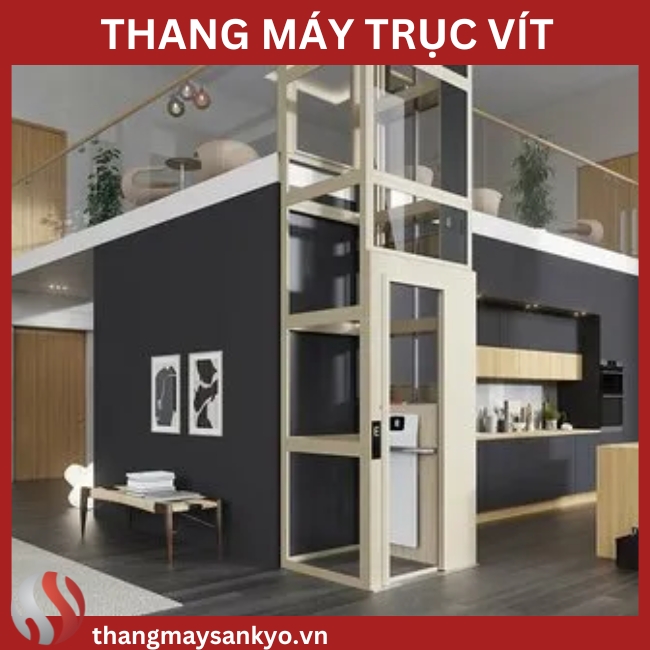
Structure of screw elevator
The structure of screw elevator includes the following main parts:
Motor :
The motor is an important part of the screw elevator system, which is responsible for providing energy to rotate the screw shaft, helping to move the elevator cabin up or down. Normally, the motor of the screw elevator can be an AC electric motor, however, depending on the design and specific requirements of each system, other types of motors can be used such as DC motors or asynchronous motors. These motors are selected to suit the needs of speed, load, and performance of the elevator. The choice of motor also depends on factors such as energy consumption, operating efficiency, and maintenance costs, helping to ensure stable operation of the elevator, energy saving and long life during use.
.jpg)
Screw :
With a characteristic spiral design, the screw shaft helps transmit rotational motion from the motor to the nut system. When the screw shaft rotates, it will pull the nut along the screw shaft, creating a pushing or pulling force, thereby helping the elevator cabin move up or down. The screw shaft is usually made of high-strength materials, such as alloy steel or high-strength metals, to ensure stable, durable operation and withstand impacts during use. In addition, the screw shaft must have high precision during the machining process to ensure performance and stability when moving. Thanks to its structure and good bearing material, the screw shaft provides smooth, precise and long-lasting operation for the elevator system.
Nut :
The nut is an important part of the screw elevator system, playing the role of directly connecting to the screw shaft to create movement for the elevator cabin. When the motor rotates, the screw shaft rotates and pulls the nut along the screw shaft. This nut is attached to the elevator cabin, helping to move the cabin up or down depending on the direction of rotation of the screw shaft. The nut is designed with high precision to ensure perfect engagement with the screw shaft, helping the elevator movement to be smooth, smooth and precise. The nut is usually made of highly wear-resistant and durable material, so that it can withstand large impact forces during long-term operation without rapid wear. In this way, the nut contributes to maintaining the performance and life of the screw elevator system , ensuring safety and stability during use.
SEE MORE PRODUCTS:
Frame :
The elevator frame is the load-bearing part and supports other parts of the elevator. Designed to ensure stability and strength, the elevator frame provides a solid foundation for components such as the cabin, screws, nuts and other moving parts. With its load-bearing structure, the elevator frame ensures that the elevator cabin can move safely, smoothly and steadily. In addition, the elevator frame must also meet the requirements of high load-bearing capacity, helping to maintain continuous operation and minimize possible incidents during use. The elevator frame is often made of durable and high-strength materials, such as stainless steel or alloy, to ensure absolute safety for the elevator. The strength and stability of the elevator frame is an important factor in maintaining the efficiency and longevity of the elevator system, while ensuring the safety of users.
Elevator cabin (Car) :
Elevator cabins serve as a moving space for passengers or goods. Designed to be attached to the nut, the cabin moves along the screw shaft as the nut moves, ensuring smooth and efficient operation. Cabins are typically sturdy in design, equipped with comfort and safety features such as automatic doors, control panels, and protective systems to ensure passenger safety. Cabin sizes can be customized to suit the needs of the application, from small models for low-rise residential buildings to more spacious cabins for high-rise buildings or freight elevators. Cabin materials are also varied, with options such as stainless steel, tempered glass, and soundproofing materials, creating a comfortable, modern, and safe moving space.
Control System :
The control system of a screw elevator consists of electronic and mechanical components, which are responsible for controlling all elevator operations, fr



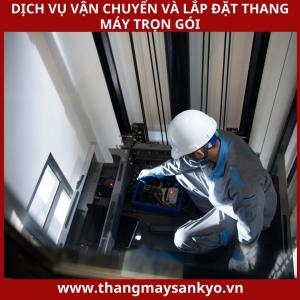
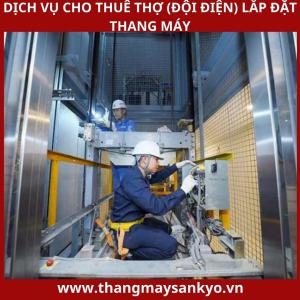


.png)
.png)

.png)






